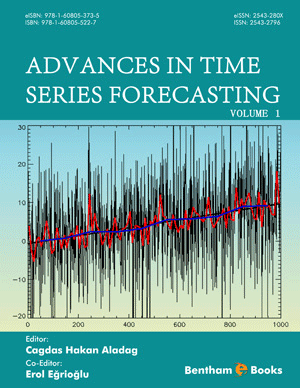Vector Algebra
Page: 1-20 (20)
Author: Carlos Polanco
DOI: 10.2174/9789811415081119010007
PDF Price: $15
Abstract
This chapter defines the concept of vectors on the real coordinate space ℝ
Real–Valued Functions
Page: 21-45 (25)
Author: Carlos Polanco
DOI: 10.2174/9789811415081119010008
PDF Price: $15
Abstract
This chapter focuses on the characterisation of a real-valued function, its graphs, and level surfaces; its limits, continuity, and differentiation. The operators here reviewed are gradient, directional derivatives, and the polynomial approximation to a function named Taylor´s theorem. All of them will be extensively used in the following chapters.
Critical Points
Page: 46-63 (18)
Author: Carlos Polanco
DOI: 10.2174/9789811415081119010009
PDF Price: $15
Abstract
This chapter focuses on the identification of the maximum, minimum, or saddle points located in the domain of the real-valued function in a graph of a function. The first part of this chapter focuses on the open set domain of a function and the second part on the closed set domain. The characterization of these points called critical points" is resolved with the Hessian matrix and the Bordered Hessian matrix. Finally, we will review the Implicit Function Theorem.
Vector-Valued Functions
Page: 64-74 (11)
Author: Carlos Polanco
DOI: 10.2174/9789811415081119010010
PDF Price: $15
Abstract
This chapter focuses on describing the vector-valued function
Integration Over Bounded Regions
Page: 75-94 (20)
Author: Carlos Polanco
DOI: 10.2174/9789811415081119010011
PDF Price: $15
Abstract
This chapter introduces Riemann’s double and triple integrals over integration domains, bounded by real-valued functions with and without the use of mappings that transform the bounded integration domains.
Integration Over Unbounded Regions
Page: 95-102 (8)
Author: Carlos Polanco
DOI: 10.2174/9789811415081119010012
PDF Price: $15
Abstract
This section reviews the integrals whose domain of integration corresponds to an unbounded region, or a partially unbounded region, on a plane or in space. This type of integrals are called improper integrals.
Integration Over Curves and Surfaces
Page: 103-112 (10)
Author: Carlos Polanco
DOI: 10.2174/9789811415081119010013
PDF Price: $15
Abstract
This chapter introduces the Line and Surface Integrals as a measure of the effect of a vector field or scalar field over oriented curves and surfaces.
Theorems of Vector Calculus
Page: 113-123 (11)
Author: Carlos Polanco
DOI: 10.2174/9789811415081119010014
PDF Price: $15
Abstract
This chapter reviews the theorems of Vector Calculus: Green’s theorem, Stokes’ theorem, and Gauss’ theorem. The approach will be done using mappings, to show the operative simplification that can be obtained.
Geometric Algebra
Page: 124-138 (15)
Author: Carlos Polanco
DOI: 10.2174/9789811415081119010015
PDF Price: $15
Abstract
This chapter intends to be a survey on Exterior Algebra. This algebra is attributed to Hermann Grassmann [Die lineare Ausdehnungslehre, ein neuer Zweig der Mathematik, 1842], and it is formed by two operators: the exterior product and inner product. William K. Clifford unified both products under the geometric product operator and David Hestenes improved the geometric and computer aspects of Geometric algebra. Here, we review the main operators and their properties, as well as their application in the representation of lines and planes.
Theorems of Differential Forms
Page: 139-148 (10)
Author: Carlos Polanco
DOI: 10.2174/9789811415081119010016
PDF Price: $15
Abstract
This chapter reviews the main aspects of the Differential forms and their application to facilitate the resolution of the integrals involved in Green’s theorem, Stokes’ theorem, and Gauss’ theorem.
Solutions for Chapters
Page: 149-176 (28)
Author: Carlos Polanco
DOI: 10.2174/9789811415081119010017
PDF Price: $15
Abstract
This chapter provides the complete solution to all the exercises pointed out at the end of each chapter of this book. The solutions not only indicate the final result, but the respective procedures are exhibited. It is recommended in all cases that the reader review the solutions to all the exercises.
Introduction
Vector calculus is an essential mathematical tool for performing mathematical analysis of physical and natural phenomena. It is employed in advanced applications in the field of engineering and computer simulations. This textbook covers the fundamental requirements of vector calculus in curricula for college students in mathematics and engineering programs. Chapters start from the basics of vector algebra, real valued functions, different forms of integrals, geometric algebra and the various theorems relevant to vector calculus and differential forms. Readers will find a concise and clear study of vector calculus, along with several examples, exercises, and a case study in each chapter. The solutions to the exercises are also included at the end of the book. This is an ideal book for students with a basic background in mathematics who wish to learn about advanced calculus as part of their college curriculum and equip themselves with the knowledge to apply theoretical concepts in practical situations.












